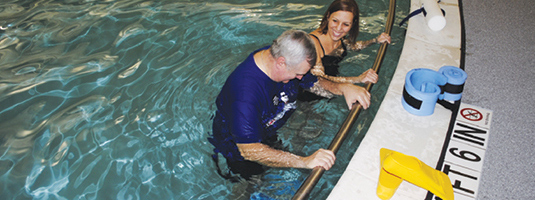Aquatic Therapy

The University of Maryland Rehabilitation Network offers a full-service aquatic therapy program that is ideal for patients who are strong enough to begin the healing process, but may still require support when walking, standing, moving and balancing.
Who Do We Treat
Patients with neurological, spinal cord or brain injuries, as well as those who are experiencing acute illnesses, balance issues, chronic pain or multi-trauma injuries often find that being in a pool allows them to build strength, increase flexibility and improve range of motion, without needing to manage their body weight. Aquatic therapy is also ideal for post-surgical patients once the surgical wound has healed.
How the Program Works
Our program begins with an initial evaluation, followed by a series of water-based therapy sessions. Some patients then move to a group therapy structure and are often linked with others who have similar challenges and goals. Our facilities feature chair lifts to raise and lower patients who are unable to get in and out of the pools using the stairs, along with hand rails. Water temperatures are maintained around 90 degrees, further helping patients with circulation, pain sensitivity issues and muscle relaxation.
Things to Know As You Begin Aquatic Therapy
- You do not have to know how to swim to participate.
- In some cases, your therapist may be in the water with you. This is beneficial for those who may be nervous about getting in the water. It is common for patients to feel a significant increase in ability, confidence and morale within a few therapy sessions.
- The buoyancy of water can actually decrease weight bearing by up to 90 percent. This means that if you are unable to support your weight on land, you will likely be able to stand in the pool without risk of falling.
- Water exercise provides resistance that can help improve your strength and cardiovascular fitness while stimulating body awareness, balance and stability.
- There are many benefits associated with submersing your body in warm water. Patients commonly experience muscle relaxation, increased circulation and decreased pain and swelling.
